
The Museo del Prado, officially known as Museo Nacional del Prado, is the main Spanish national art museum, located in central Madrid. It houses collections of European art, dating from the 12th century to the early 20th century, based on the former Spanish royal collection, and the single best collection of Spanish art. Founded as a museum of paintings and sculpture in 1819, it also contains important collections of other types of works. The numerous works by Francisco Goya, the single most extensively represented artist, as well as by Hieronymus Bosch, El Greco, Peter Paul Rubens, Titian, and Diego Velázquez, are some of the highlights of the collection. Velázquez and his keen eye and sensibility were also responsible for bringing much of the museum's fine collection of Italian masters to Spain, now one of the largest outside of Italy.

Francisco de Zurbarán was a Spanish painter. He is known primarily for his religious paintings depicting monks, nuns, and martyrs, and for his still-lifes. Zurbarán gained the nickname "Spanish Caravaggio", owing to the forceful use of chiaroscuro in which he excelled.

Museo di Capodimonte is an art museum located in the Palace of Capodimonte, a grand Bourbon palazzo in Naples, Italy designed by Giovanni Antonio Medrano. The museum is the prime repository of Neapolitan painting and decorative art, with several important works from other Italian schools of painting, and some important ancient Roman sculptures. It is one of the largest museums in Italy. The museum was inaugurated in 1957.

The Assumption of the Virgin is an oil on canvas painting by Greek artist Doménikos Theotokópoulos, known as El Greco, in 1577–1579. The painting was a central element of the altarpiece of the church of Santo Domingo el Antiguo in Toledo, Spain. It was the first of nine paintings that El Greco was commissioned to paint for this church. The Assumption of the Virgin was El Greco's first work in Toledo and started his 37-year career there. Under the influence of Michelangelo, El Greco created a painting that in essence was Italian, with a naturalistic style, monumental figures, and a Roman school palette. The composition of El Greco's depiction of the Assumption of the Virgin resembles Titian's Assumption in the Basilica dei Frari in Venice with Virgin Mary and angels above and the apostles below. On the painting Virgin Mary floats upward which symbolizes her purity, while apostles gathered around her empty tomb express amazement and concern.

Saint Luke is a painting by an artist known as El Greco. The painting is an oil on canvas created sometime around 1610–1614. It is currently held by the Indianapolis Museum of Art in Indianapolis, Indiana.

The El Greco Museum is located in Toledo, Spain. It celebrates the mannerist painter El Greco, who spent much of his life in Toledo, having been born in Fodele, Crete.
The Doña María de Aragón Altarpiece was an altarpiece painted between 1596 and 1599 by El Greco for the chapel of the Colegio de la Encarnación in Madrid. The college was secularised during Goya's lifetime and the altarpiece was dismantled. There has been much speculation over which paintings belonged to the work. The consensus view is that it consisted of six large canvases and a seventh, now lost. Five of those six canvases are now in the Prado and the sixth is in the National Museum of Art of Romania in Bucharest.

Saint Anthony of Padua is a 1580 oil on canvas painting by El Greco, now in the Museo del Prado in Madrid.

The Fable is a 1580 allegorical painting by El Greco, produced early in his Toledan period and now in the Museo del Prado in Madrid.
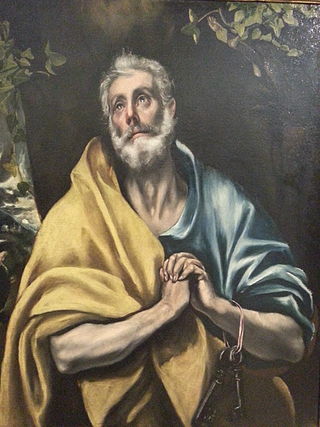
The Tears of Saint Peter or Penitent Saint Peter is a c.1587-1596 painting by El Greco. It is similar to other works on the same subject by the artist, such as those in the Bowes Museum, the El Greco Museum, the national museum in Stockholm and others.

Saint Peter and Saint Paul is a 1587-1592 painting by El Greco, one of several versions of the theme by the artist - others are now in Barcelona and Stockholm. It shows the apostles saint Peter and saint Paul. The work was once shown on a stamp produced by the USSR.

Saint Andrew and Saint Francis is a 1595-1598 painting by El Greco, produced in Toledo, Spain and now in the Museo del Prado in Madrid.
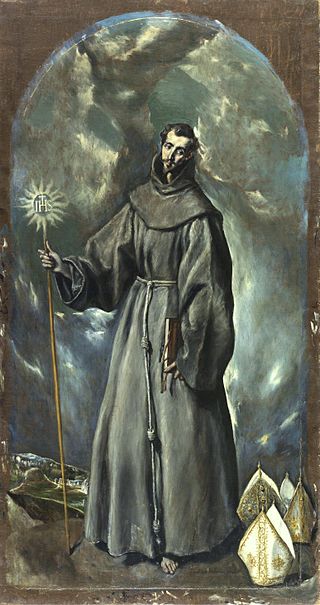
Saint Bernardino of Siena is a 1603 work by El Greco. It is owned by the Museo del Prado but displayed at the El Greco Museum in Toledo, Spain.

Saint Francis of Assisi in Ecstasy is a lost painting by El Greco. A c.1600 work in the collection of the Museo del Prado was once thought to be the work itself, but is now thought to be an anonymous 17th century copy of it, a work by one of his followers or a work from his studio.
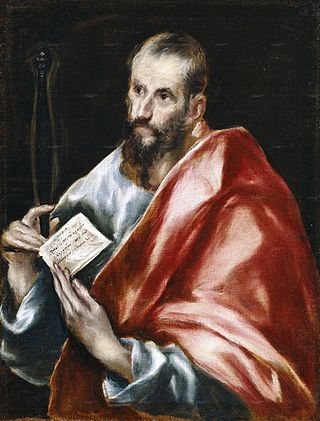
Saint Paul is a 1610-1614 painting by El Greco, now in the Museo del Prado in Madrid. The painting is key to Gregorio Marañón's theory that the painter used mental patients at the Hospital del Nuncio as models.
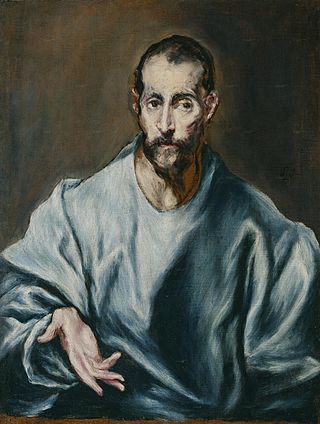
Saint James the Great is a 1610 painting of James the Great by El Greco, now in the Museo del Prado. The painting is key to Gregorio Marañón's theory that the painter used mental patients at the Hospital del Nuncio as models.
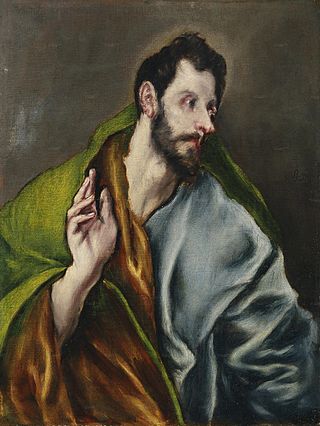
Saint Thomas the Apostle is a 1608–1614 painting of Thomas the Apostle by El Greco, now in the Museo del Prado.

The Tears of Saint Peter, Penitent Saint Peter or St. Peter Repentant is a c.1590 painting by El Greco, now in the National Museum of Art, Architecture and Design in Oslo, Norway. Other variants of the work are in the Bowes Museum, the El Greco Museum, Museo Soumaya and others.

The Penitent Saint Peter is a painting by El Greco. It is part of the collection of the San Diego Museum of Art and depicts a praying Saint Peter, one of Jesus' apostles.


















